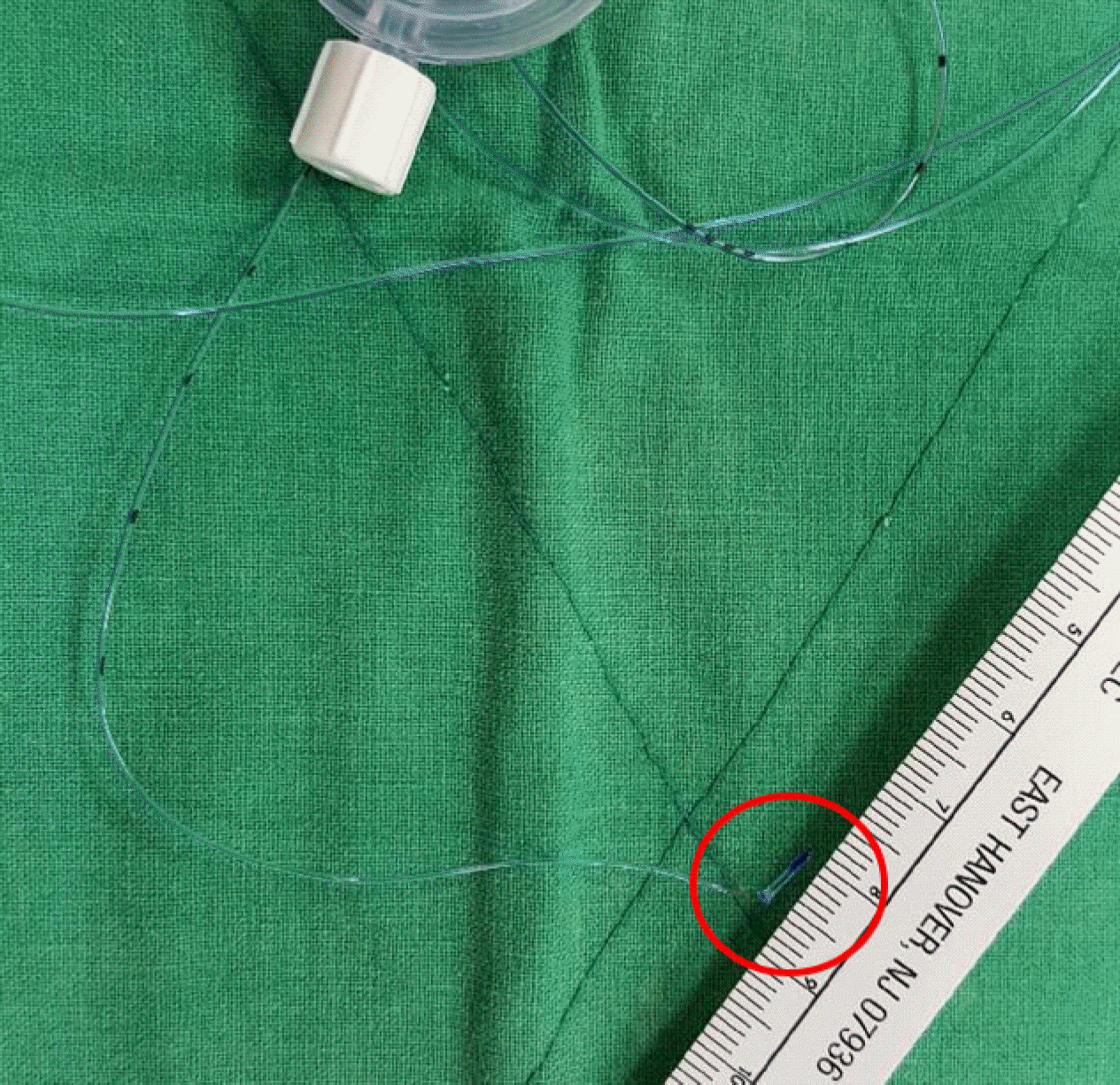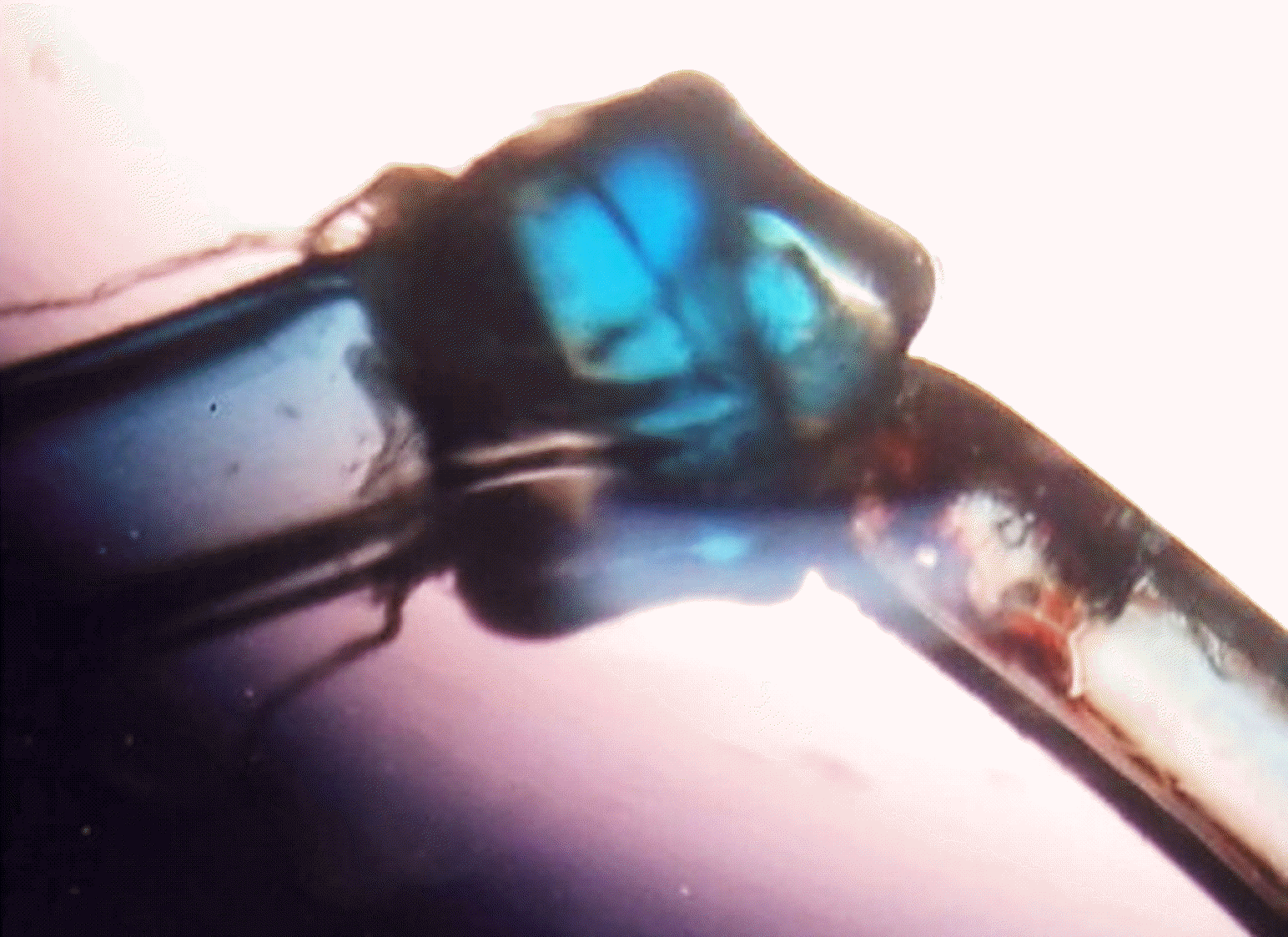Abstract
Knotting of an epidural catheter occurs very rarely with an estimated incidence of 0.0015%. We present a case of an epidural catheter knot formed at removal of an epidural catheter following a forceful insertion of the catheter against resistance met at the entrance of the epidural space during threading of the catheter through Tuohy needle placed uneventfully in a 65 year-old male patient undergoing epidural anesthesia. During removal of the epidural catheter, significant resistance was encountered on traction and it was found that approximately 1.5 ㎝ portion of the catheter had been retained within the patient's subcutaneous tissue. Firm traction was employed to withdraw the catheter against the resistance. The catheter was pulled out uneventfully from the patient. A knot estimated to be formed during removal of the catheter was observed at 0.6 ㎝ proximal to the catheter tip. No complications and side effects were noted until the patient's discharge.
Go to : 
References
1. McGregor PJ. In reply. Anesthesiology. 1990; 73:1293.
2. Brichant JF, Bonhomme V, Hans P. On knots in epidural catheters: A case report and a review of the literature. Int J Obstet Anesth. 2006; 15:159–62.

3. Aslanidis T, Fileli A, Pyrgos P. Management and visualization of a kinked epidural catheter. Hippokratia. 2010; 14:294–6.
4. Singh V, Bhakta P, Ahuja A. Epidural catheter knot immediately after catheter insertion. Anaesth Intensive Care. 2015; 43:280–1.
5. Sexton AJ. Double kinking of a thoracic catheter within the epidural space. Anaesth Intensive Care. 2012; 40:732–3.
6. Fibuch EE, McNitt JD, Cussen T. Knotting of the theracath after an uneventful epidural insertion for cesarean delivery. Anesthesiology. 1990; 73:1293.

7. Chang PY, Hu J, Lin YT, Chan KH, Tsou MY. Butterfly-like knotting of a lumbar epidural catheter. Acta Anaesthesiol Taiwan. 2010; 48:45–8.

8. Gabopoulou Z, Mavrommati P, Chatzieleftheriou A, Vrettou V, Konstandinidou M, Velmachou K. Epidural catheter entrapment caused by a double knot after combined spinal-epidural anesthesia. Reg Anesth Pain Med. 2005; 30:588–9.

9. Dam-Hieu P, Rodriguez V, De Cazes Y, Quinio B. Computed tomography images of entrapped epidural catheter. Reg Anesth Pain Med. 2002; 27:517–9.

10. Lee CS, Kim SW, Shin JH, Park SY, Lee SC. Ultrasound-guided removal of epidural catheter breakage after percutaneous epidural neuroplasty. Anesth Pain Med. 2011; 6:321–4.
11. Boey SK, Carrie LE. Withdrawal forces during removal of lumbar extradural catheters. Br J Anaesth. 1994; 73:833–5.

12. Benzon HT, McCarthy RJ, Benzon HA, Kendall MC, Robak S, Lindholm PF, et al. Determination of residual antiplatelet activity of clopidogrel before neuraxial injections. Br J Anaesth. 2011; 107:966–71.

13. Mehran R, Baber U, Steg PG, Ariti C, Weisz G, Witzenbichler B, et al. Cessation of dual antiplatelet treatment and cardiac events after percutaneous coronary intervention (PARIS): 2 year results from a prospective observational study. Lancet. 2013; 382:1714–22.

14. Chassot PG, Delabays A, Spahn DR. Perioperative antiplatelet therapy: The case for continuing therapy in patients at risk of myocardial infarction. Br J Anaesth. 2007; 99:316–28.

15. Bateman BT, Mhyre JM, Ehrenfeld J, Kheterpal S, Abbey KR, Argalious M, et al. The risk and outcomes of epidural hematomas after perioperative and obstetric epidural catheterization: A report from the multicenter perioperative outcomes group research consortium. Anesth Analg. 2013; 116:1380–5.
Go to : 
 | Fig. 1.A knot of the epidural catheter is observed at 0.6 cm proximal to the catheter tip (red circle). |
 | Fig. 2.The magnified view of the knot under a light microscope shows a reduced diameter of the epidural catheter proximal to the knot due to a significant tension against resistance encountered during removal of the catheter and a small amount of blood presumably from an epidural vein injured from forceful placement of the epidural catheter despite resistance upon insertion of the catheter into the epidural space. |




 PDF
PDF ePub
ePub Citation
Citation Print
Print


 XML Download
XML Download